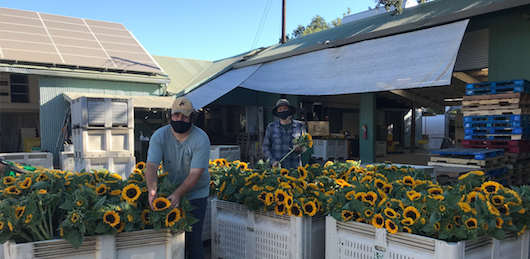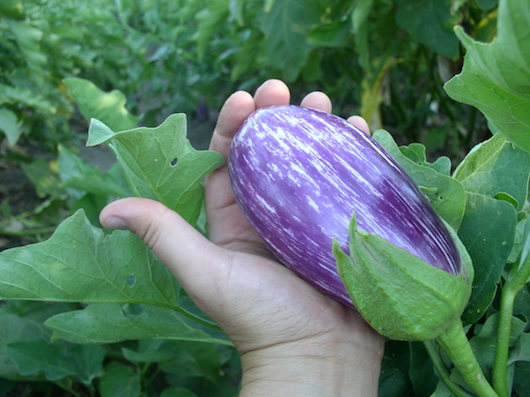
Ellis and Andrew with six bins of sunflowers that they helped to pick —
Viewed close in on a summer’s day, it would be fair to say that Full Belly Farm grows a lot of tomatoes, potatoes, peppers and eggplants — all members of the same large botanical family of plants called Solanacea, also known as Nightshades. On many summer afternoons, a good portion of the crew, including owners can be found in the tomato fields picking, or in the packing shed surrounded on all sides by boxes of tomatoes.
Viewed from a bit farther out, with a different perspective, it turns out that Full Belly actually grows a lot of other things as well — but the preponderance of Nightshades in the summer has been the recent subject of many a comment from our members. The Nightshade family includes plants that contain a diverse range of alkaloid substances that have invaluable pharmaceutical properties — but are also sometimes poisonous. For example, belladonna (“deadly nightshade”), jimson weed, mandrake and tobacco are in this family. When potatoes are left out in the light, the green color that you sometimes see is a sign that the potato has developed some alkaloids and should not be eaten.

Japanese Eggplant
Potatoes, peppers and tomatoes are new world plants, but eggplants are believed to have originated in India — it’s hard to know since they are eaten all over the world. Eggplants have been cultivated in southern and eastern Asia since prehistory. They continue to grow wild throughout the Mediterranean. Just as watermelons aren’t always red inside, eggplants aren’t always purple on the outside. There are many varieties cultivated now and apparently the name eggplant came from a white, goose-egg shaped variety.

Listada Eggplant
Both eggplants and potatoes like to soak up olive oil, cream or whatever lovely fattening substance you care to add. Here’s what Deborah Madison says about eggplants, in her wonderful book, Vegetable Literacy:
“You can do hundreds of things with eggplants in the kitchen, and often in the company of tomatoes, which are flourishing in the garden at the same time. Think of an eggplant flan with a tomato sauce, grilled eggplant rounds with a tomato salad, a tomato and eggplant gratin. Eggplant can play a supporting role in a dish, as in ratatouille, or it can stand alone as a dip, a spread, or a side dish. You can slice large, round eggplants, grill or broil the slices, then crown them with any number of toppings: a parsley-pine-nut salad or an herb salad, a tomato salsa, saffron-scented ricotta with salt-roasted tomatoes, tartar sauce with pomegranate seeds, a spicy peanut sauce. The same slices can be rolled around a filling, used to make eggplant gratins, or layered in a pasta-free lasagna with ricotta and tomatoes. Eggplant can be roasted or grilled until soft and the pulp mashed and used to make a smoky baba ghanoush.”
After a comment in last week’s newsletter, many of our members shared their eggplant ideas as well:
‘I love the eggplants so please keep them coming!! Two things I did this past week that may make some new converts: frying them up in Panko and unsweetened coconut flakes and dipping in sweet chili sauce to make something like coconut shrimp. Or thinly slicing, sprinkling with salt and letting them sit, patting dry and layering with tomato sauce and mozzarella, then baking. Excellent over pasta or on a sandwich!’
“I love eggplant, and how I cook it is simple and involves no oil, labor, or clean up. I slice the eggplant lengthwise, put face down on a tray lined with parchment paper, and cook at 350º for 40 to 60 minutes depending on size. It’s done or near done when wrinkles appear on the skin. After cooking, I let the tray sit on the counter for a few minutes so the eggplant won’t stick to the parchment. Then I turn the eggplant over, scrape the innards away from the skin with a fork, and eat. It is delicious!”
“This is what we do: I slice them into round slices, about 3/8″ thickness, lay them on towel paper in separated layers, and leave them overnight for their moisture to drain. Then I fry them in olive oil (I use the light type) until they are soft. The fried slices are drained of excess oil on paper and served dressed with salt to taste and finely chopped garlic. We had them for lunch over cream cheese on Naan bread.”
Some of our members have Nightshade intolerance and are trying to avoid the entire family, thus the summer boxes aren’t working well for them. We are sympathetic and sad about this — But luckily it seems that there are plenty of our members who are not Nightshade intolerant, on the contrary, we seem to have some true Nightshade lovers in our midst.
Blessings on your meals.
— Judith Redmond

Wendell has been a fixture of the Berkeley farmers markets for decades. He cleans up the street after the market trucks have left and trades for flowers and food as payment.
